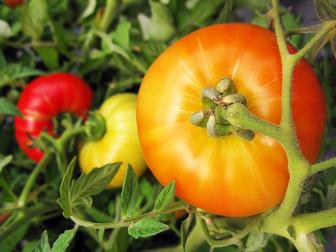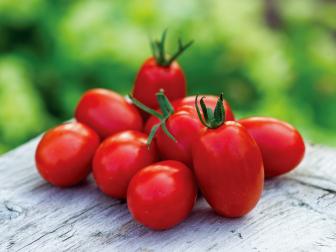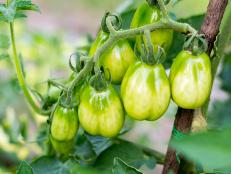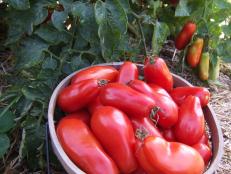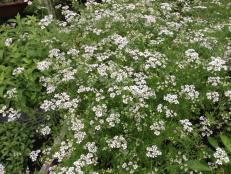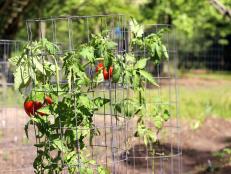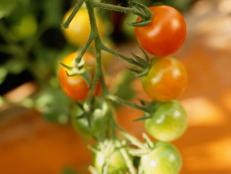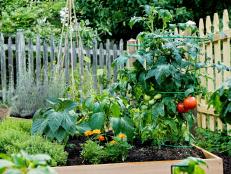Why Do Tomatoes Split?
When it comes to taste, homegrown tomatoes beat those hard, red supermarket orbs hands down. Learn why tomatoes crack and split and what to do about it.
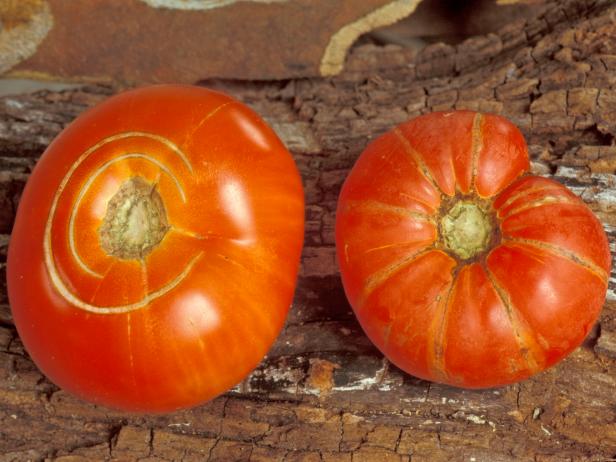
National Gardening Association
Tomatoes that split or crack may look bad, but act fast, and you may be able to use them.

Don't supermarket tomatoes look good? They’re round and red and blemish-free. But looks can be deceiving, and those store-bought beauties don’t usually deliver the rich, meaty taste of homegrown fruits (technically speaking, tomatoes are fruits). That’s why it’s so disappointing when the tomatoes growing in your garden start to split and crack.
All types of tomatoes can split or crack. Radial cracking means the tomatoes have vertical cracks or splits that run from their stems to the bottoms of the fruits. Tomatoes can also develop concentric cracks that look like rings or circles between the stems and the shoulders of the fruits. Radial cracks are worse because they expose more of the tomato's flesh to diseases and pests. Concentric cracks are less likely to expose the insides, so they’re not usually as bad.
Does Overwatering Cause Tomatoes to Split?
Yes. Too much water is the primary reason that tomatoes split. It happens because all that water makes the tomato’s flesh grow faster than its skin can grow, and eventually the skin bursts. This often happens when there’s a lot of rain after a period of dry weather. It can also occur if the soil around your plants doesn't stay moist because you’re not watering evenly and consistently. Tomatoes need an inch to 2 inches of water per week and wide fluctuations of moisture in the soil can cause this kind of damage.
Some tomato growers say that quick, extreme changes in temperature, such as going from hot days to cool nights, can also cause rapid growth that leads to cracks and splits.
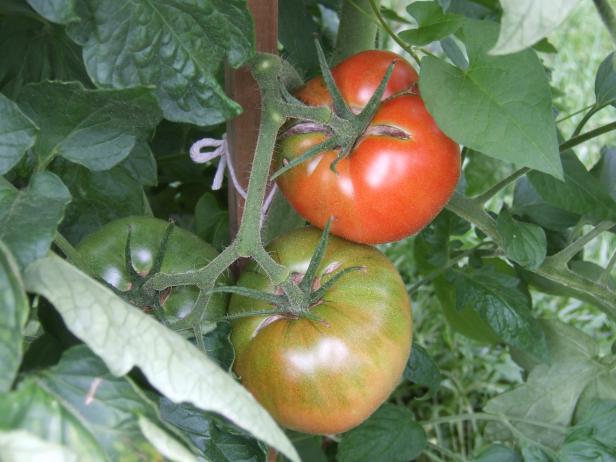
Julie Martens Forney
Tomatoes can crack after plants quickly take up water from heavy rains that soak dry soil and the ripening fruits outgrow their skins.
Why Are My Tomatoes Splitting Before They Get Ripe?
Tomatoes can split at any stage of growth, whether they're green or in the process of ripening. Again, this happens when the soil doesn't stay evenly and consistently moist. Green tomatoes that split or crack will usually rot if they’re left to ripen on the vine.
Can You Eat Tomatoes That Split?
You can eat tomatoes with splits or cracks as long as they don’t smell sour, ooze, or show signs of pests or diseases. Avoid soft or mushy tomatoes, too, which may be starting to rot. Just act fast and harvest your fruits as soon as you see the cracks and splits, even if they're green, and let them finish ripening indoors. They probably won’t be as tasty as tomatoes that ripen on the vine, but if you can cut off the bad parts, and the rest of the fruits feel firm and look and smell okay, they won’t be a total loss.
How to Plant, Grow and Care for Tomatoes
Consider this your ultimate guide to choosing tomato plants, planting, growing and caring for tomatoes, and harvesting the best-tasting tomatoes ever.
What Can I Do When Tomatoes Split?
If you don't want to pick your immature cracked or split tomatoes and bring them indoors to ripen, do what some gardeners do, and let them finish ripening on the vine. If you can’t see the flesh of the tomato through the cracks and splits, there’s a chance that pests and disease-causing organisms haven’t gotten in yet. Just keep an eye on them, and don't use any parts of tomatoes you're unsure about.
To avoid splits and cracks in the first place, keep your soil evenly and consistently moist, and water deeply to encourage the tomatoes to form good roots. Use soaker hoses or a drip irrigation system instead of a hand-held hose or sprinkler. Water sprayed from a hand-held nozzle or sprinkler could evaporate in the air or run off before it’s absorbed into the ground. Keep the leaves of your plants dry, too, since wet foliage can invite disease. Use 2 or 3 inches of organic mulch or compost around your tomatoes to help hold the moisture in the soil.
If your local weather report says heavy rains are headed your way, you may want to go ahead and pick your tomatoes and let them ripen indoors.
You can also help prevent splitting and cracking by planting your tomatoes in raised beds or containers. Use soil that drains easily and containers with drainage holes so excess water can escape. If you’re planting directly in the garden, work your soil at least 12 inches deep and mix in lots of good organic materials or compost. Add a little perlite, if needed, to loosen the soil. (It’s better to dig a whole bed than individual holes, which can collect too much water.)
Some growers think soils that contain a lot of nitrogen and too little potassium can cause cracking. If you suspect the nutrients in your soil are out of balance, do a soil test or ask your county extension service agent to test it for you.
Fertilizing your tomatoes to keep them healthy can also help. Use a product labeled for tomatoes or vegetables and apply it as directed on the package.
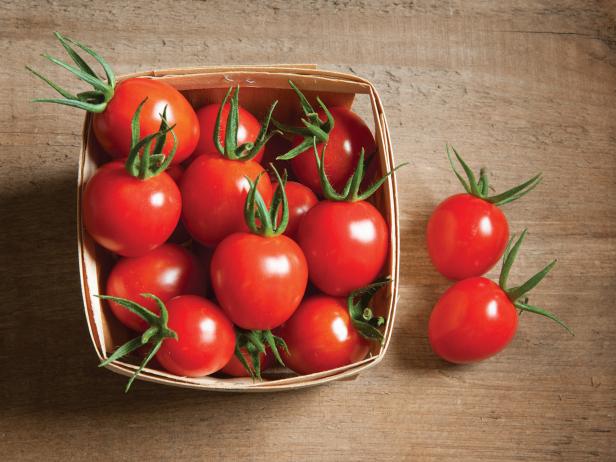
Johnny's Selected Seeds
Small tomatoes like 'Cherry Bomb' from Johnny’s Selected Seeds can split and crack just like bigger types.
Finally, plant tomato varieties that are labeled as crack resistant — even though that doesn't guarantee they'll never crack or split. All kinds of tomatoes, from beefsteaks to grape types, heirlooms, Romas and more can develop these problems.
What’s Wrong With My Tomato? 15 Photos
Learn how to troubleshoot common tomato plant issues such as blossom end rot, hornworms and blight, and then learn how to fix them.
Tomatoes Varieties That Resist Cracking
Some varieties have "elastic" skins that stretch more than others, so they can hold a lot of water. Here are a few to try.
'Daybreak ' — These bright red tomatoes are ready 62 days from planting. The plants are indeterminate (that is, the vines grow and bear fruit until the first killing frost and may need to be caged or staked for support).
'Baxter’s Early Bush' — This early-maturing, compact variety bears cherry tomatoes that are ready to harvest in about 70 to 72 days.
'Marglobe' — The vines of this heirloom tomato have a sprawling growth habit and need staking, although they're considered determinate (which means the vines grow to a certain height and then stop growing and bearing). 'Marglobe' resists Verticillium and Fusarium wilt as well as cracking and splitting. Fruits mature in 70 to 80 days.
'Heinz' — Another indeterminate variety, this low-acid tomato stays relatively compact. Its fruits need at least 72 days to mature.
'Mountain Spring' — Ready to pick in 65 to 75 days, this determinate tomato's fruits have a mild taste and can reach 8 to 10 ounces.
'Mountain Fresh' — Tolerant of cool, wet growing conditions, this determinate tomato resists Fusarium wilt, nematodes and Verticillium wilt as well as cracking. Fruits mature in 75 to 80 days.
"Jet Star' — The meaty, low-acid tomatoes on this plant need at least 72 days after planting to mature. The indeterminate vines need staking.

%20Taniya%20Nayak,%20Ty%20Pennington,%20Alison%20Victoria,%20and%20Brian%20and%20Sarah%20Baeumler_BOTB_HGTV%20.jpg.rend.hgtvcom.196.196.suffix/1683310636672.jpeg)




